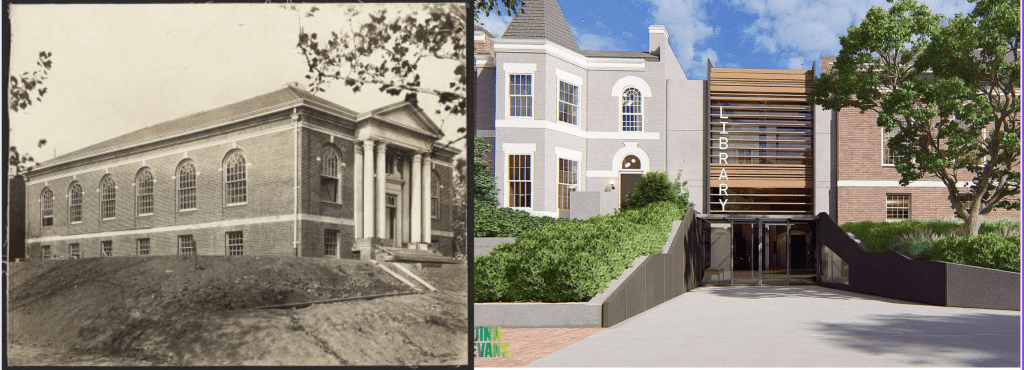By Zsana Hoskins
Special to the AFRO
In one month D.C.’s Southeast Library, located at 403 7th street in Washington, D.C., will close for a $33 million renovation to modernize the building. The renovation work to the historic Carnegie-funded library will begin Jan. 4, 2024 and is expected to take approximately two years to complete.
“The new Southeast Library will expand the 7,943 square foot building to a 17,547 square foot building that will feature expanded space for children, teens and adults,” said George Willams, the media relations director for D.C. Public Library. Williams added that the upgraded facility will include more space for books, more computers, seating and preservation and restoration of the building’s historic elements.”
The historic building opened in 1922 and was designated a historic landmark by the D.C. Historic Preservation Review Board on March 25, 2021. The one-story building was the second neighborhood library to be built in the District and was designed by Edward L. Tilton. It was purchased with $8,360 from Congress and bolstered by $67,000 in construction funding from the Carnegie Corporation.
The new Southeast Library will expand the 7,943 square foot building to a 17,547 square foot building that will feature expanded space for children, teens and adults.
As the need for updates presented itself, the library hosted eight community meetings to ensure community input was considered in the design plans. The team also conducted a survey, and hosted focus groups for community feedback, according to the D.C. Public Library (DCPL) website.
Also according to the website, the project was reviewed by the Advisory Neighborhood Committee (ANC), the D.C. Historic Preservation Review Board, The U.S. Commission of Fine Arts, and the Capitol Hill Restoration Society.
The new additions will also include a universally accessible entrance and maintenance of the original historic entrance. There will be a restoration of the exterior landscape, environmentally sustainable design and more study spaces under the guidance of architectural firm Quinn Evans and design partner Whiting-Turner Contracting Company.
Chuck Wray, the Quinn Evans’ principal in charge of the overall construction process, spoke with the AFRO to highlight some of the unique features the new library will include.
“One of our design drivers has been the focus on natural light,” Wray shared. “The original architect of the Library, Edward L. Tilton, was one of the first to advocate that libraries should be filled with natural light. Taking this to heart, we worked to bring light to the two new underground floors.”
“The final design includes a new, large roof-top skylight that is located over the historic upper level and a series of floor openings that connect the underground levels below. There is also a grade-level skylight over one edge of the children’s area located on the lowest floor.”
Wray also highlighted the commitment to sustainability in the renovation plans, stating the project has been designed to meet the LEED v4 Gold sustainability benchmark.
“Our efforts have been concentrated in improving the energy performance of the existing structure, designing a highly energy efficient addition, and incorporating as many sustainability best practices as possible,” Wray said.
Advisory Neighborhood Commissioner David Sobelsohn of 6B03 is excited about the renovations but believes there are some flaws in the plans.
“The library system has not thought through the process of renovating the library, nor committed to the kind of maintenance the new library will require. Other projects, including the Eastern Market Metrorail Plaza right across from the library, show the fallacy of thinking that new construction by itself provides enough resources for a community. It takes dedicated maintenance,” said Sobelsohn.
According to statistics from City-Data, there are over 112,000 residents in the Southeast area. With the closure of the neighborhood library, Sobelsohn anticipates several challenges residents may face during the renovation period, especially since the next closest library is the Northeast branch, over a mile away from Carnegie.
Despite Sobelsohn’s claims, DCPL still believes the Northeast location to be sufficient for residents over the next two years.
“The Northeast Library not only offers a full-service library as the interim location, but also provides greater accessibility for those with disabilities, due to its historic modernization. This includes features like wider aisles and doors, lower service counters, and a handicap-accessible ramp at the entrance. We encourage Southeast Library visitors to explore these accessibility upgrades during the temporary closure period,” said DCPL in an email statement.
To combat some of these issues, Sobelsohn and the community are making efforts to fill in the gaps that the renovations may cause.

“Through community efforts, we found places for our book groups, including kids’ storytime. Following our suggestion, our Ward Six council member Charles Allen secured funds to maintain a part-time library facility at the Arthur Capper Recreation Center. Arthur Capper would also offer the first library resources for residents of the Navy Yard area part of Ward Eight,” Sobelsohn added.
Sobelsohn also claims that, although these alternate arrangements have been made, D.C. Public Library “threatens to make it difficult for residents to use the Arthur Capper facility.”
Sobelsohn said the Arthur Capler Recreation Center will have limited hours, will not provide access to enough resource materials, or open soon enough for residents to use. The ANC Commissioner even advocated for a closure delay, as he believes residents were not given enough notice about the library renovations.
“Without evening or weekend hours, most working people, and even school-age children, won’t have much chance to use the facility. The library system won’t guarantee that we can return books to Arthur Capper. The library system continues to call the Northeast branch the interim facility for Southeast residents, even though the system has no plans—none—to enhance the resources at the Northeast branch to accommodate Southeast residents,” Sobelsohn claimed.
In response to Sobelsohn’s claims, DCPL stated via email:
“The hours of service at Arthur Capper are designed to meet the needs of residents who need internet access and computer help: job seekers, students after school, and residents who have no other options for internet access,” the statement read.
“The Library cannot provide services at Capper immediately after the Southeast closure because staff will be preparing the library for construction and moving equipment currently at Southeast to Arthur Capper and other locations.”
As far as Sobelsohn’s request to postpone the closure, DCPL said a delay beyond the six-week notice they’ve already provided will increase the overall cost of the project.
The final community meeting regarding the renovations was held on Dec. 14 in Meeting Room 1 at the Southeast Library where Whiting-Turner discussed the logistics of what to expect during the construction.
The post Southeast library to close for renovations appeared first on AFRO American Newspapers.











